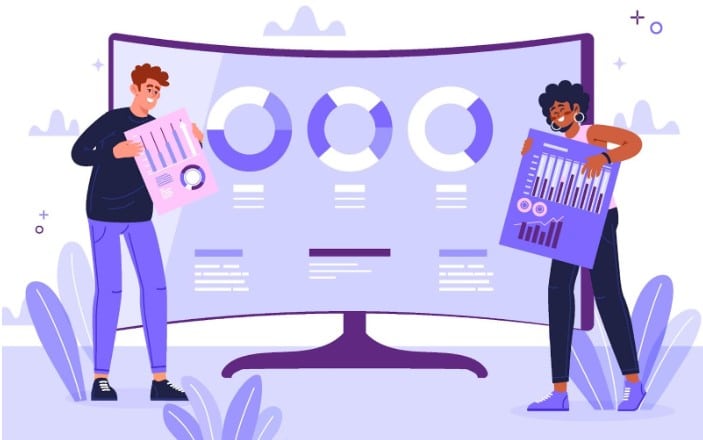Customer anonymity behind their desktop or mobile screens is no longer an obstacle for marketers. That’s because it’s now possible to study consumer behavior on and offline to make informed and data-enhanced decisions.
How is this possible? The answer lies in behavioral analytics. This marketing game-changer is introducing benefits few thought were possible in both the business-to-consumer (B2C) and business-to-business (B2B) space.
Keep reading because this comprehensive guide offers you detailed insights into behavioral analytics to help shape your marketing strategies.

Understanding Behavioral Analytics
First things first: let’s explore the concept of behavioral analytics. In short, this is a business intelligence and development decision-making process that drives marketing strategies based on how consumers interact with a brand online and offline. It considers data such as browsing and search history, IPs, cookies, etc.
Based on concrete and quantifiable data points, marketers can now study consumer behaviors and actions and watch for gaps, trends, and areas for improvement. They can also personalize marketing campaigns for more effective results on the business’ bottom line. Ultimately, by studying user data, marketers can uncover patterns and gain a deeper understanding of their consumers to tailor products, services, campaigns, programs, copy, and more to them.
While behavioral analytics informs marketing campaigns, it should not be confused with demographics. That’s because demographics indicates what social and personal level a consumer is at but it does not aim to predict their behavior or actions. Furthermore, it’s a helpful asset in helping marketers map our customer journeys to create frictionless experiences.
Types of behavioral analytics and key metrics to track
Not every data point and metric will be valuable to every business or marketer. However, certain strategies, like leveraging backlinks, can influence your needs and goals. Here’s a quick overview of a few types of behavioral analytics that you can use for strategic marketing decision making:
- Product analytics: Aiming to understand how customers interact with your product, you can track both web and mobile usage as well as purchasing patterns. Some important metrics that help capture important data include: activation and retention rates, monthly active users, customer lifetime value, feature usage frequency, time spent on a product, use of biometrics, etc.
- Web analytics: This focuses on how users spend their time on websites and web-based platforms. A few metrics to measure could include page views, bounce rates, click-through rates, session duration, unusual web activity (for cybersecurity), etc.
- Marketing analytics: Through marketing analytics, it’s possible to determine and measure customer interactions with specific marketing campaigns. These include email newsletters, social media adverts, pay-per-click (PPC) campaigns, and more. Open, click-through, and conversion rates are the most frequently used metrics to measure success.
- Social media analytics: Considered a subset of marketing analytics, these metrics measure the ways in which consumers engage with your company’s social media accounts. Likes, shares, comments, follower growth, lead generation through social media, and others are just a few examples of metrics to measure.
- In-app analytics: These data points focus on user engagement within an app. It can be measured through client-side inputs such as clicks, hovers, keystrokes, etc. More in-depth metrics could include time spent in the app, revenue generated, the value of payments, and more as part of event tracking.
How Behavioral Analytics Can Transform Your Marketing Campaigns
Overall, behavioral analytics can help marketers understand and better develop personalized ads, targeted emails, dynamic website content, smoother product recommendations, retarget abandoned carts, and so much more. Here are several benefits that are worth mentioning when it comes to the importance of using and implementing the results of behavioral analytics:
- Understanding your customers better
- Enhancing the user experience (UX)
- Improving engagement with your website, app, content, etc.
- Converting indecisive customers
- Improving content personalization
- Better content optimization
- Boosting customer satisfaction rates
- Enhanced targeting
- Predicting customer needs
- Enhancing customer conversion and retention
- Cross-sell and upsell opportunities
- Optimized sales processes
- Better insights for product development
- Enhancing the customer experience through improved customer support
- Identifying high-value customers
- Preventing churn
- Spotting bugs
- Increasing product adoption
- Making product improvements
- Helping you determine average order size
- Keeping your brand top of mind
- Strengthening customer relationships
By using behavioral analytics to guide these strategies, businesses can further refine their overall operations and decision-making. In fact, for those looking to integrate strategic insights with automated processes, tools like an AI Business plan generator can streamline the process of creating tailored business strategies that reflect consumer behavior insights, optimizing both marketing and business outcomes.
By extending the use of behavioral analytics, businesses can also benefit from tools like an hours calculator, which provides a deeper understanding of how customers allocate their time across various marketing activities. This tool complements insights from behavioral data by identifying patterns that reveal which strategies drive the highest engagement and conversions. Armed with this information, marketers can prioritize high-performing channels, optimize time management, and align their efforts with consumer preferences. Additionally, an hours calculator offers a means to evaluate campaign efficiency, ensuring that resources are focused on initiatives with the greatest impact. Together, these tools empower businesses to make precise, data-driven decisions that enhance both operational and marketing effectiveness.
Tools for Behavioral Analytics
The world of digital marketing tools is absolutely skyrocketing. This means you can choose a tool that helps you with your specific marketing needs. A few examples of tools you can use to gain insights into your customers’ behavior include A/B testing and session replay tools, heatmaps, voice of customer and survey or assessment tools, and many others.
What’s important with each one of these is that they’re capable of integrating with your customer relationship management (CRM) and email platforms. Some tools worth mentioning include:

Whichever tool you settle on, be sure to look out for a solution that features a combination of functionalities such as session replay capabilities, heatmaps, user segmentation, A/B testing, and funnel analysis.
How to Get Started with Behavioral Analytics for Your Campaigns
Businesses differ from each other in terms of niche and industry, marketing objectives and campaigns, and target audience, among other things. However, that doesn’t mean that you can’t apply a behavioral analytics approach to your marketing campaigns. Leveraging artificial intelligence, you can gain deeper insights and ensure better results by following the right sequence of steps. Here are some recommendations to keep in mind as you embark on this journey.
1) Define clear goals
First, figure out what you’re going to measure and where. If you have an e-commerce website, you’ll want to have clear metrics to see the entire purchase journey from start to finish. If you have an app, you’ll want to see how your users interact with it and whether there are any friction points. Each metric you choose to monitor should reflect your ultimate campaign goals and objectives.
2) Collect data
With clear goals and key performance indicators (KPIs) in sight, it’s time to start collecting data from various touchpoints on your website, emails, app, social media channels, etc. Depending on the metrics you will be tracking, you also need to watch out for every interaction your customer has with your digital marketing platform. Keep an eye out for points of friction, rage clicks, and follow the customer journey as closely as possible so that you can refine the UX and your next campaign better.
3) Segmentation
When you’ve collected your data, you should try to identify groups of customers based on common behaviors or patterns. Examples of possible segmentations you could pursue include frequent buyers, first-time visitors, customers who abandoned carts, etc.
4) Targeted messaging, campaign development, and execution
Next up, it’s time to create personalized experiences for your different segments. Make sure your marketing messages speak to your buyers in their specific place of the journey. For example, a customer who abandoned their cart could get a follow-up email with a special discount to encourage them to complete the purchase. Ensure that the right message reaches the right customer segment timeously.
5) Testing, optimization, and continuous improvement
Once you’ve executed your marketing campaign and distributed your content across the most relevant channels to reach different customer segments, you need to constantly monitor the results and work on ongoing optimization. This is a continuous process that has no end. It’s about always working to refine what’s working and removing obstacles and friction at every possible opportunity. The more data you collect and the more steps you take to improve your customer experience, the more efficient, smart, and effective your campaigns will be.
Challenges in Collecting and Using Behavioral Data
Collecting and using behavioral data for behavioral analytics and smarter marketing campaigns isn’t without its challenges. These should be borne in mind as you proceed on the road ahead because failing to do so could mean exposing your campaign and business to certain risks. Here’s what you should be aware of:
- The need for compliance with privacy and data protection and collection laws such as GDPR and CCPA
- The importance of respecting consumer advertising preferences and honoring consumer choices
- Failing to deploy automated data lifecycle management systems to ensure timely deletion or retention of data through accurate schedules
- Not implementing easy-to-navigate data access portals that facilitate easier viewing, transfer, and/or deletion of personal data
- Failing to integrate data from various sources to create more accurate buyer personas and customer profiles
- Neglecting to maintain scalable data infrastructure
- Failing to train your team to effectively manage customer data, such as data protection officers
- Not implementing inter-departmental workflows and collaboration to ensure smoother project management and campaign execution
- Not addressing business reputation risks by neglecting to adopt a transparent approach to data usage accompanied by clear communication
Despite these challenges, it’s possible to create a culture of openness, transparency, and accountability in your organization to boost customer trust and satisfaction and ensure a strong brand reputation. To ensure you do this, be sure you are completely open about how you collect data and how you use it. Make sure to obtain customer consent, when required.
Apart from this, be sure you keep customer data safe and secure and maintain its integrity. Also, by developing strong data governance, you can better comply with regulatory requirements.
Ultimately, data should be used as an asset, and as such, should be treated with integrity and respect. This takes time and an organization-wide commitment. However, once in place and with ongoing improvements, you can truly benefit from your customers’ behavioral analytics to ensure greater business success.
Conclusion: Making the Most of Behavioral Analytics
In short, behavioral analytics are a powerful tool for personalization, prediction, and optimization. It’s important to start leveraging behavioral data today to create smarter, more impactful marketing campaigns. If you’ve already started, what behavioral analytics insights have you used to improve your campaigns? Feel free to share your insights.



